Finance Module: Quantitative Calculations Assignment - University
VerifiedAdded on 2022/09/17
|16
|1299
|25
Homework Assignment
AI Summary
This assignment solution covers various quantitative calculations in finance. It includes calculations for determining the monthly payments needed to accumulate a specific future value, net present value (NPV) analysis to assess investment viability, and future value calculations for diversified portfolios and superannuation accounts. The solution also explores the differences between nominal, real, and notional interest rates and analyzes the impact of changes in the cash rate by the Reserve Bank of Australia. Furthermore, the assignment delves into dividend imputation, holding period returns, and market analysis, including standard deviation, beta, and the application of the Capital Asset Pricing Model (CAPM) to determine expected returns. The solution provides detailed formulas, workings, and interpretations of the results, along with relevant references.

Running head: QUANTITATIVE CALCULATIONS
Quantitative Calculations
Name of the Student:
Name of the University:
Author Note:
Quantitative Calculations
Name of the Student:
Name of the University:
Author Note:
Paraphrase This Document
Need a fresh take? Get an instant paraphrase of this document with our AI Paraphraser

1QUANTITATIVE CALCULATIONS
Table of Contents
Answer to Question 1:................................................................................................................2
Answer to Question 2:................................................................................................................5
Answer to Question 3:................................................................................................................6
Table of Contents
Answer to Question 1:................................................................................................................2
Answer to Question 2:................................................................................................................5
Answer to Question 3:................................................................................................................6
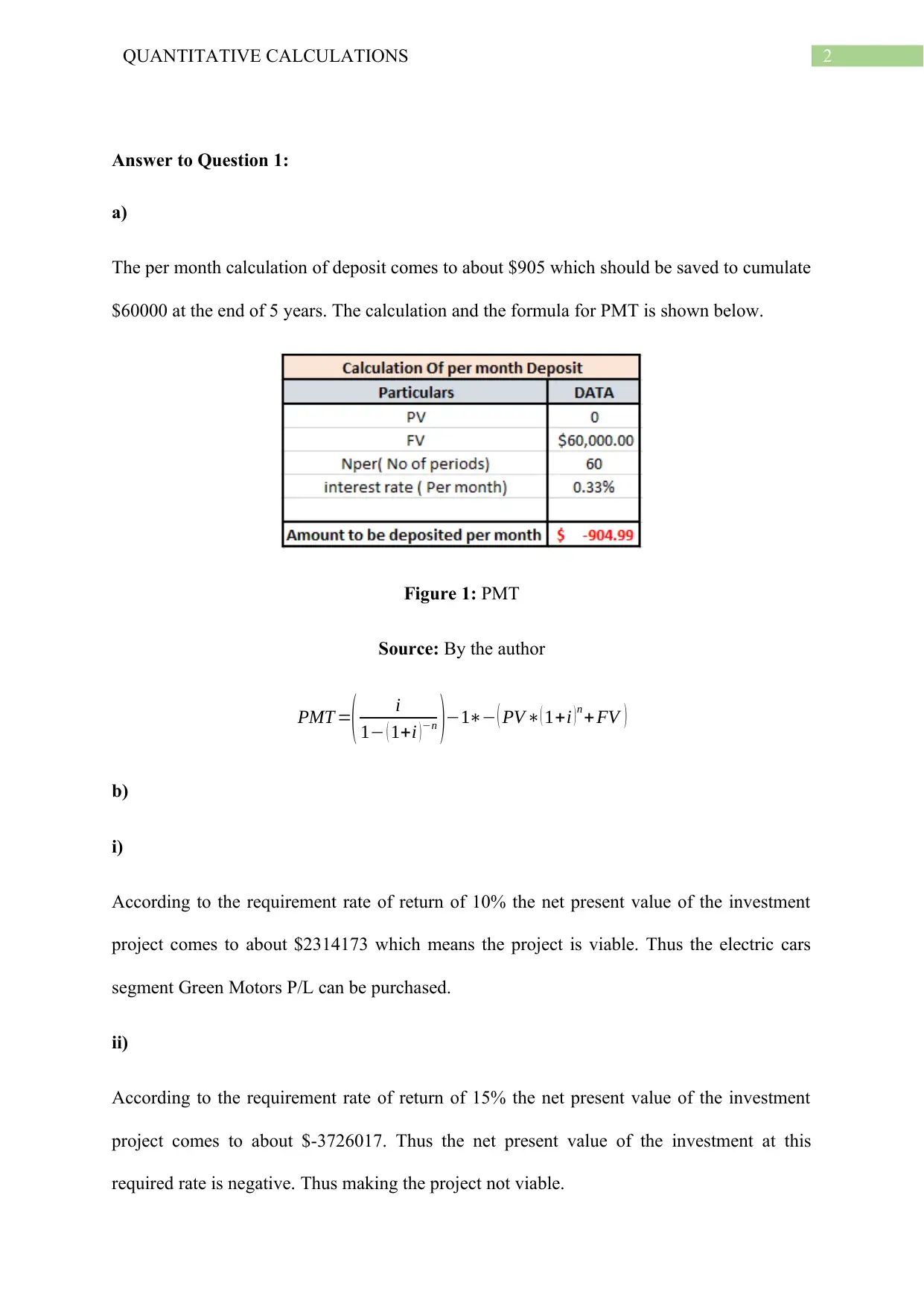
2QUANTITATIVE CALCULATIONS
Answer to Question 1:
a)
The per month calculation of deposit comes to about $905 which should be saved to cumulate
$60000 at the end of 5 years. The calculation and the formula for PMT is shown below.
Figure 1: PMT
Source: By the author
PMT =
( i
1− ( 1+i )−n )−1∗− ( PV∗( 1+i )n + FV )
b)
i)
According to the requirement rate of return of 10% the net present value of the investment
project comes to about $2314173 which means the project is viable. Thus the electric cars
segment Green Motors P/L can be purchased.
ii)
According to the requirement rate of return of 15% the net present value of the investment
project comes to about $-3726017. Thus the net present value of the investment at this
required rate is negative. Thus making the project not viable.
Answer to Question 1:
a)
The per month calculation of deposit comes to about $905 which should be saved to cumulate
$60000 at the end of 5 years. The calculation and the formula for PMT is shown below.
Figure 1: PMT
Source: By the author
PMT =
( i
1− ( 1+i )−n )−1∗− ( PV∗( 1+i )n + FV )
b)
i)
According to the requirement rate of return of 10% the net present value of the investment
project comes to about $2314173 which means the project is viable. Thus the electric cars
segment Green Motors P/L can be purchased.
ii)
According to the requirement rate of return of 15% the net present value of the investment
project comes to about $-3726017. Thus the net present value of the investment at this
required rate is negative. Thus making the project not viable.
⊘ This is a preview!⊘
Do you want full access?
Subscribe today to unlock all pages.

Trusted by 1+ million students worldwide
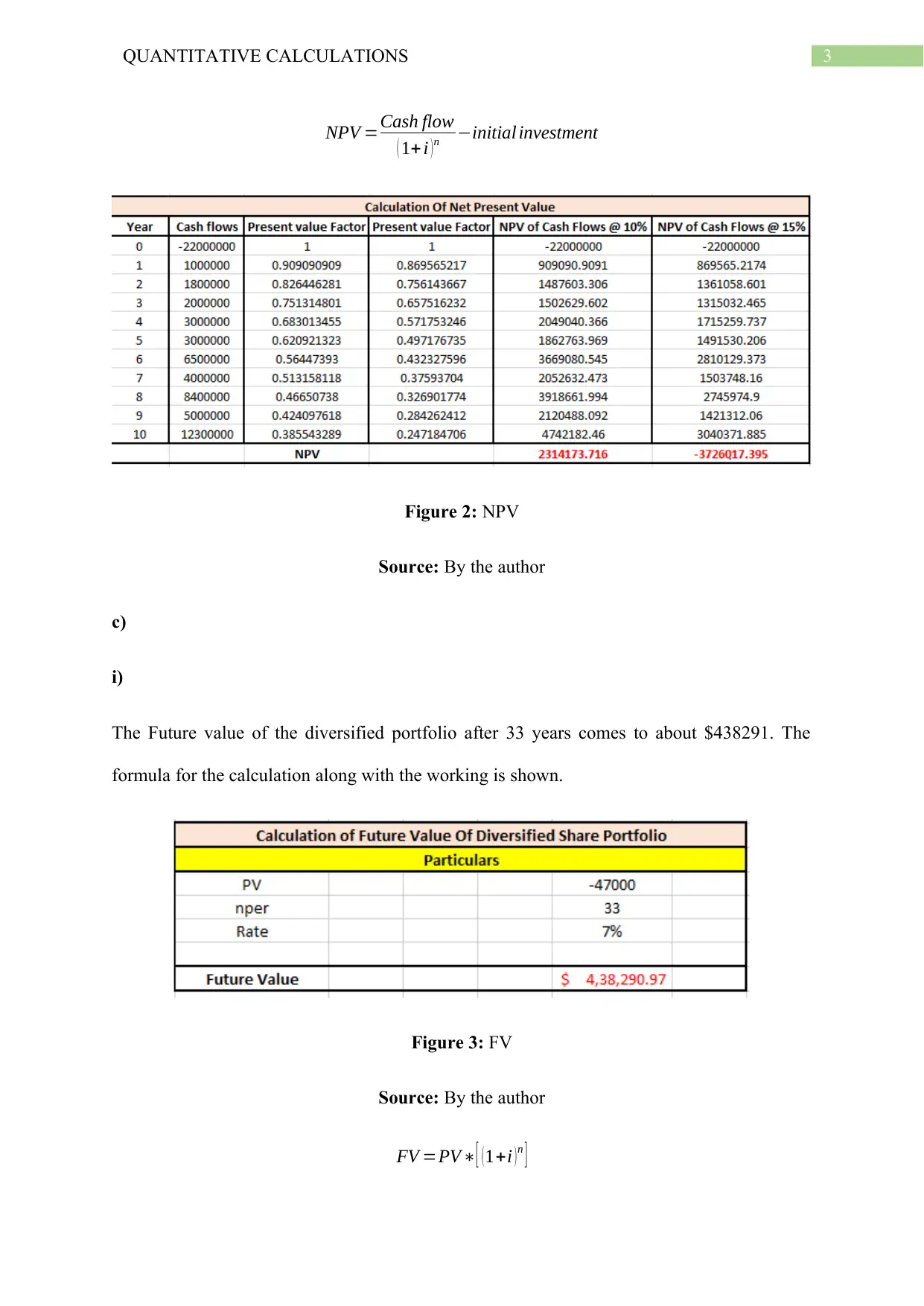
3QUANTITATIVE CALCULATIONS
NPV =Cash flow
( 1+ i )n −initial investment
Figure 2: NPV
Source: By the author
c)
i)
The Future value of the diversified portfolio after 33 years comes to about $438291. The
formula for the calculation along with the working is shown.
Figure 3: FV
Source: By the author
FV =PV∗[ (1+i )n ]
NPV =Cash flow
( 1+ i )n −initial investment
Figure 2: NPV
Source: By the author
c)
i)
The Future value of the diversified portfolio after 33 years comes to about $438291. The
formula for the calculation along with the working is shown.
Figure 3: FV
Source: By the author
FV =PV∗[ (1+i )n ]
Paraphrase This Document
Need a fresh take? Get an instant paraphrase of this document with our AI Paraphraser
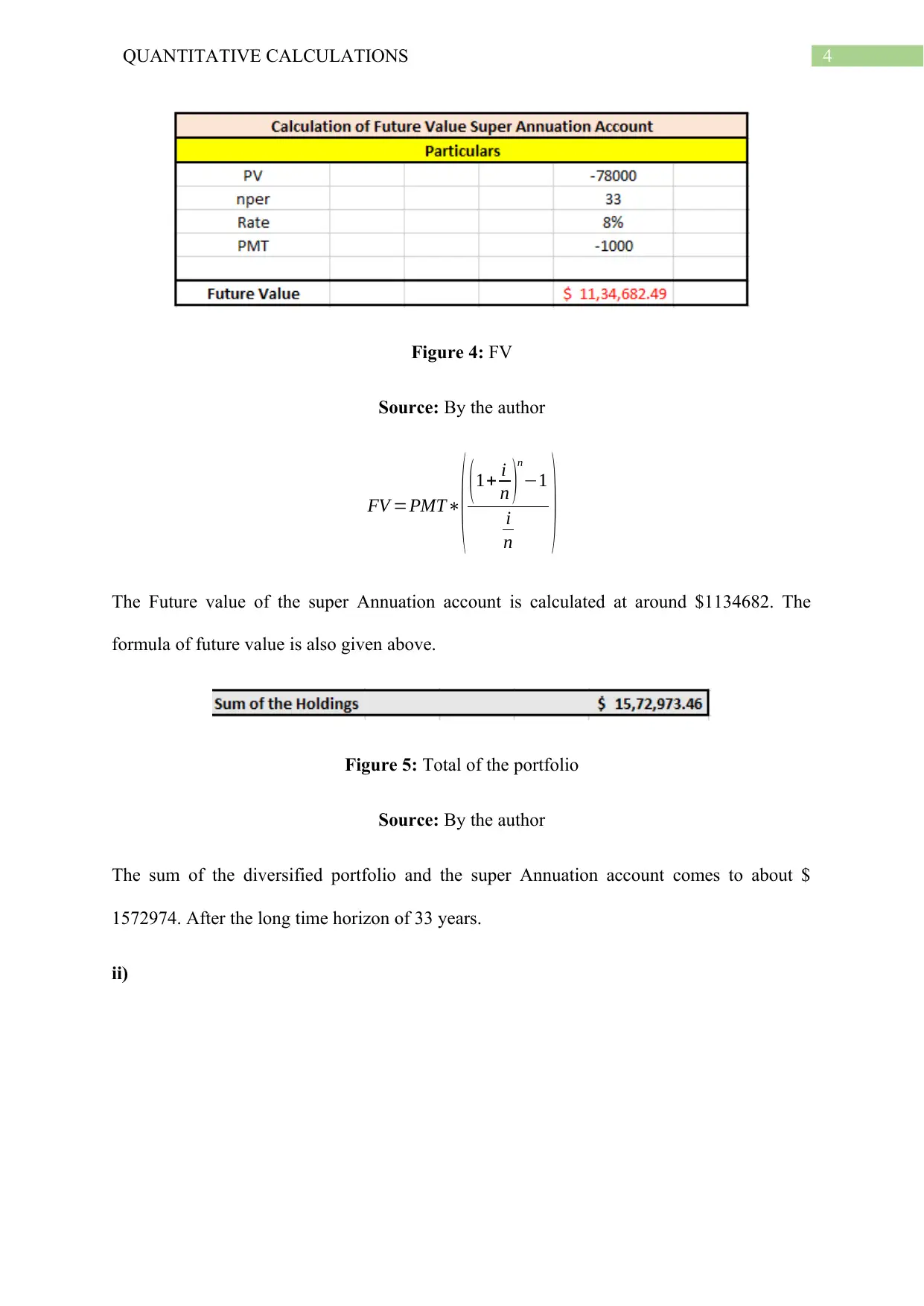
4QUANTITATIVE CALCULATIONS
Figure 4: FV
Source: By the author
FV =PMT∗
( ( 1+ i
n )
n
−1
i
n )
The Future value of the super Annuation account is calculated at around $1134682. The
formula of future value is also given above.
Figure 5: Total of the portfolio
Source: By the author
The sum of the diversified portfolio and the super Annuation account comes to about $
1572974. After the long time horizon of 33 years.
ii)
Figure 4: FV
Source: By the author
FV =PMT∗
( ( 1+ i
n )
n
−1
i
n )
The Future value of the super Annuation account is calculated at around $1134682. The
formula of future value is also given above.
Figure 5: Total of the portfolio
Source: By the author
The sum of the diversified portfolio and the super Annuation account comes to about $
1572974. After the long time horizon of 33 years.
ii)
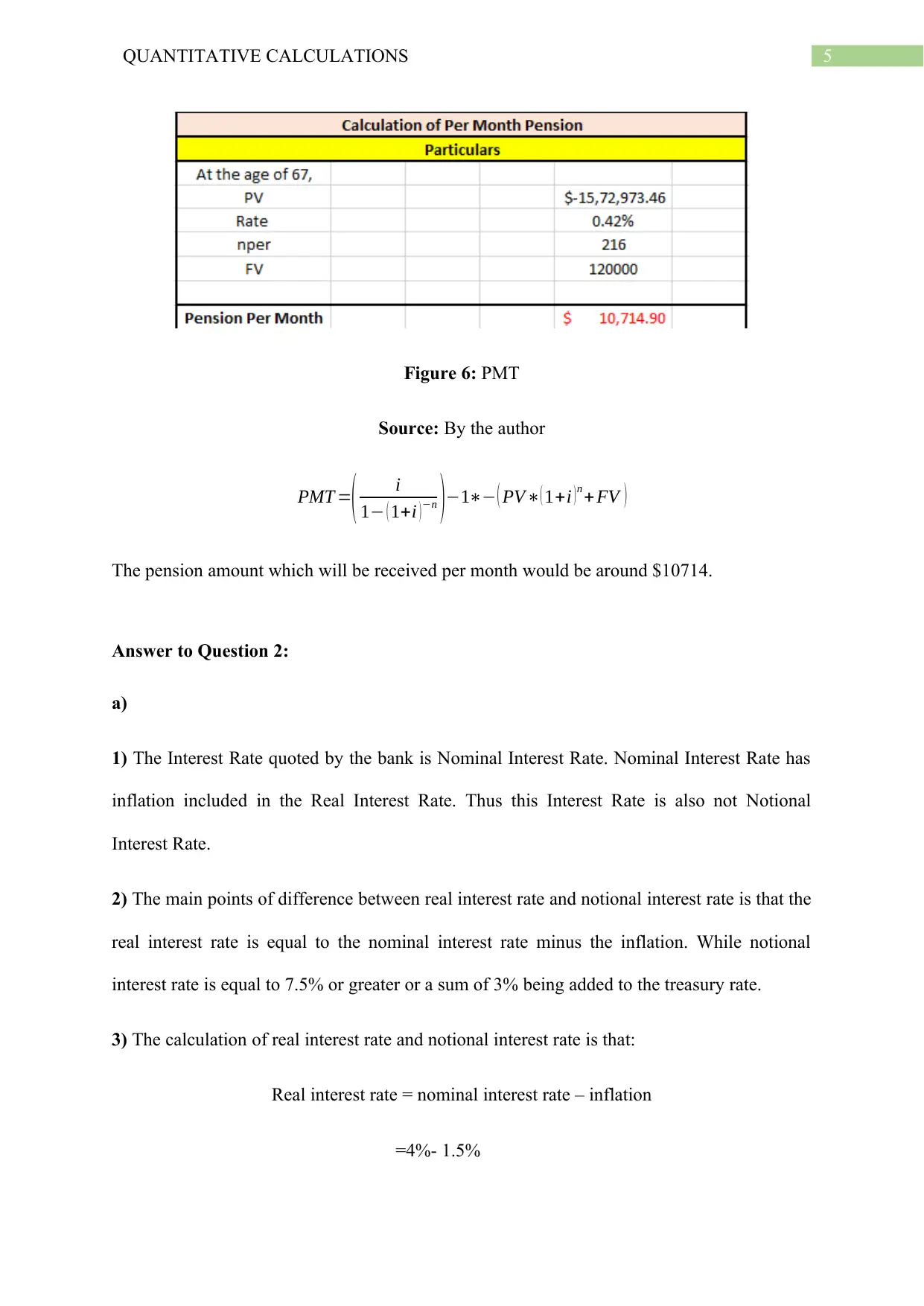
5QUANTITATIVE CALCULATIONS
Figure 6: PMT
Source: By the author
PMT =
( i
1− ( 1+i ) −n )−1∗− ( PV∗( 1+i ) n + FV )
The pension amount which will be received per month would be around $10714.
Answer to Question 2:
a)
1) The Interest Rate quoted by the bank is Nominal Interest Rate. Nominal Interest Rate has
inflation included in the Real Interest Rate. Thus this Interest Rate is also not Notional
Interest Rate.
2) The main points of difference between real interest rate and notional interest rate is that the
real interest rate is equal to the nominal interest rate minus the inflation. While notional
interest rate is equal to 7.5% or greater or a sum of 3% being added to the treasury rate.
3) The calculation of real interest rate and notional interest rate is that:
Real interest rate = nominal interest rate – inflation
=4%- 1.5%
Figure 6: PMT
Source: By the author
PMT =
( i
1− ( 1+i ) −n )−1∗− ( PV∗( 1+i ) n + FV )
The pension amount which will be received per month would be around $10714.
Answer to Question 2:
a)
1) The Interest Rate quoted by the bank is Nominal Interest Rate. Nominal Interest Rate has
inflation included in the Real Interest Rate. Thus this Interest Rate is also not Notional
Interest Rate.
2) The main points of difference between real interest rate and notional interest rate is that the
real interest rate is equal to the nominal interest rate minus the inflation. While notional
interest rate is equal to 7.5% or greater or a sum of 3% being added to the treasury rate.
3) The calculation of real interest rate and notional interest rate is that:
Real interest rate = nominal interest rate – inflation
=4%- 1.5%
⊘ This is a preview!⊘
Do you want full access?
Subscribe today to unlock all pages.

Trusted by 1+ million students worldwide
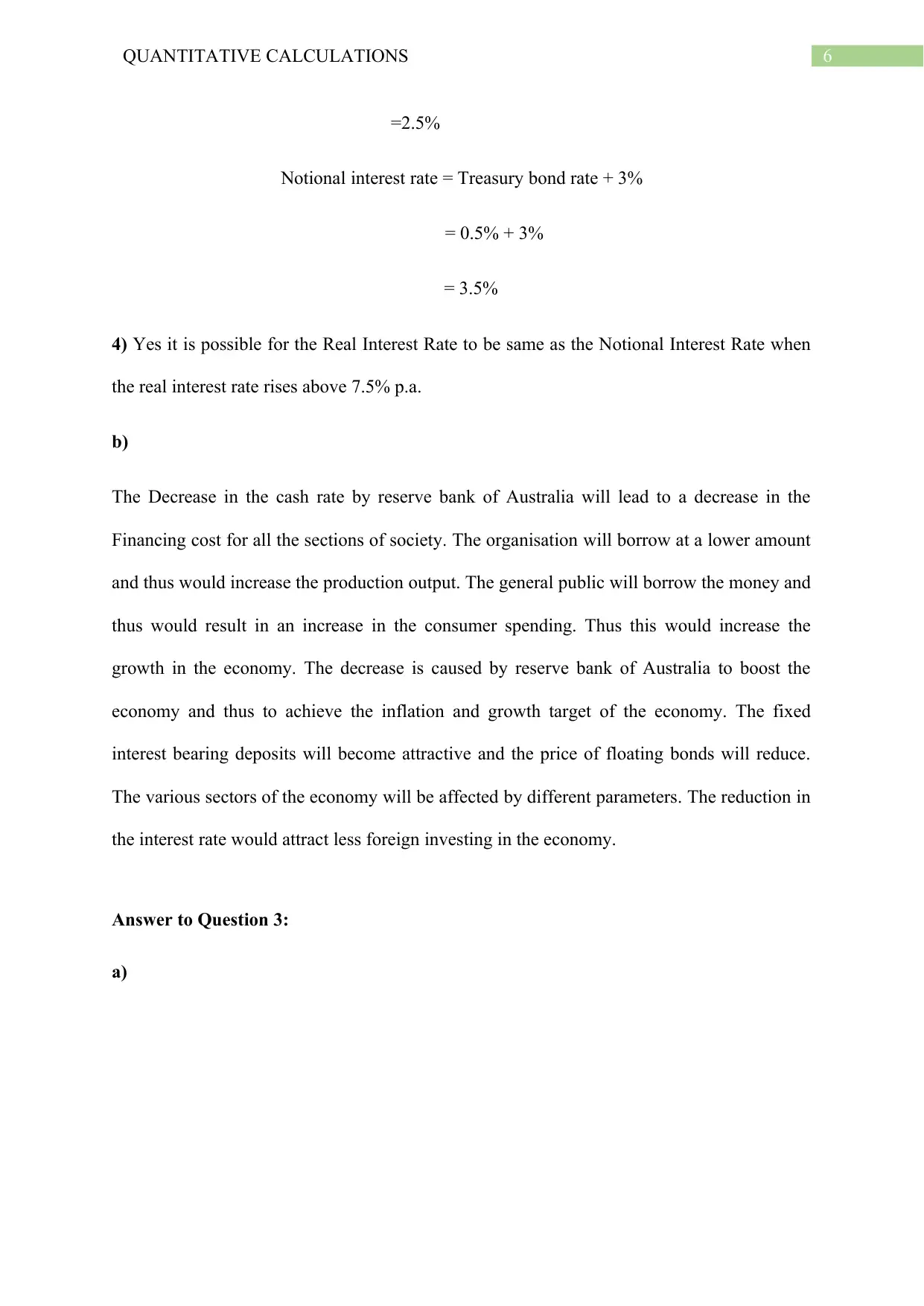
6QUANTITATIVE CALCULATIONS
=2.5%
Notional interest rate = Treasury bond rate + 3%
= 0.5% + 3%
= 3.5%
4) Yes it is possible for the Real Interest Rate to be same as the Notional Interest Rate when
the real interest rate rises above 7.5% p.a.
b)
The Decrease in the cash rate by reserve bank of Australia will lead to a decrease in the
Financing cost for all the sections of society. The organisation will borrow at a lower amount
and thus would increase the production output. The general public will borrow the money and
thus would result in an increase in the consumer spending. Thus this would increase the
growth in the economy. The decrease is caused by reserve bank of Australia to boost the
economy and thus to achieve the inflation and growth target of the economy. The fixed
interest bearing deposits will become attractive and the price of floating bonds will reduce.
The various sectors of the economy will be affected by different parameters. The reduction in
the interest rate would attract less foreign investing in the economy.
Answer to Question 3:
a)
=2.5%
Notional interest rate = Treasury bond rate + 3%
= 0.5% + 3%
= 3.5%
4) Yes it is possible for the Real Interest Rate to be same as the Notional Interest Rate when
the real interest rate rises above 7.5% p.a.
b)
The Decrease in the cash rate by reserve bank of Australia will lead to a decrease in the
Financing cost for all the sections of society. The organisation will borrow at a lower amount
and thus would increase the production output. The general public will borrow the money and
thus would result in an increase in the consumer spending. Thus this would increase the
growth in the economy. The decrease is caused by reserve bank of Australia to boost the
economy and thus to achieve the inflation and growth target of the economy. The fixed
interest bearing deposits will become attractive and the price of floating bonds will reduce.
The various sectors of the economy will be affected by different parameters. The reduction in
the interest rate would attract less foreign investing in the economy.
Answer to Question 3:
a)
Paraphrase This Document
Need a fresh take? Get an instant paraphrase of this document with our AI Paraphraser
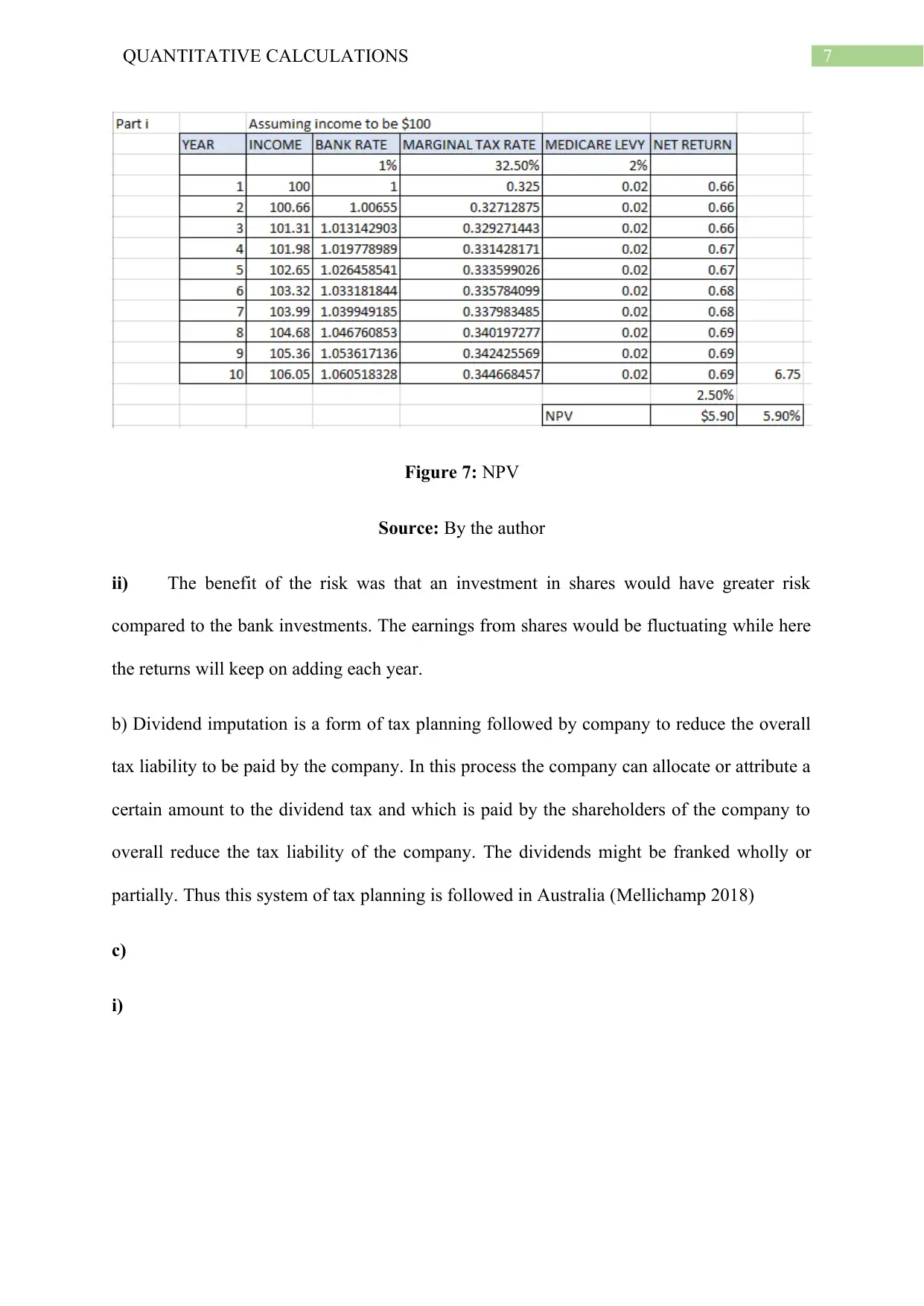
7QUANTITATIVE CALCULATIONS
Figure 7: NPV
Source: By the author
ii) The benefit of the risk was that an investment in shares would have greater risk
compared to the bank investments. The earnings from shares would be fluctuating while here
the returns will keep on adding each year.
b) Dividend imputation is a form of tax planning followed by company to reduce the overall
tax liability to be paid by the company. In this process the company can allocate or attribute a
certain amount to the dividend tax and which is paid by the shareholders of the company to
overall reduce the tax liability of the company. The dividends might be franked wholly or
partially. Thus this system of tax planning is followed in Australia (Mellichamp 2018)
c)
i)
Figure 7: NPV
Source: By the author
ii) The benefit of the risk was that an investment in shares would have greater risk
compared to the bank investments. The earnings from shares would be fluctuating while here
the returns will keep on adding each year.
b) Dividend imputation is a form of tax planning followed by company to reduce the overall
tax liability to be paid by the company. In this process the company can allocate or attribute a
certain amount to the dividend tax and which is paid by the shareholders of the company to
overall reduce the tax liability of the company. The dividends might be franked wholly or
partially. Thus this system of tax planning is followed in Australia (Mellichamp 2018)
c)
i)
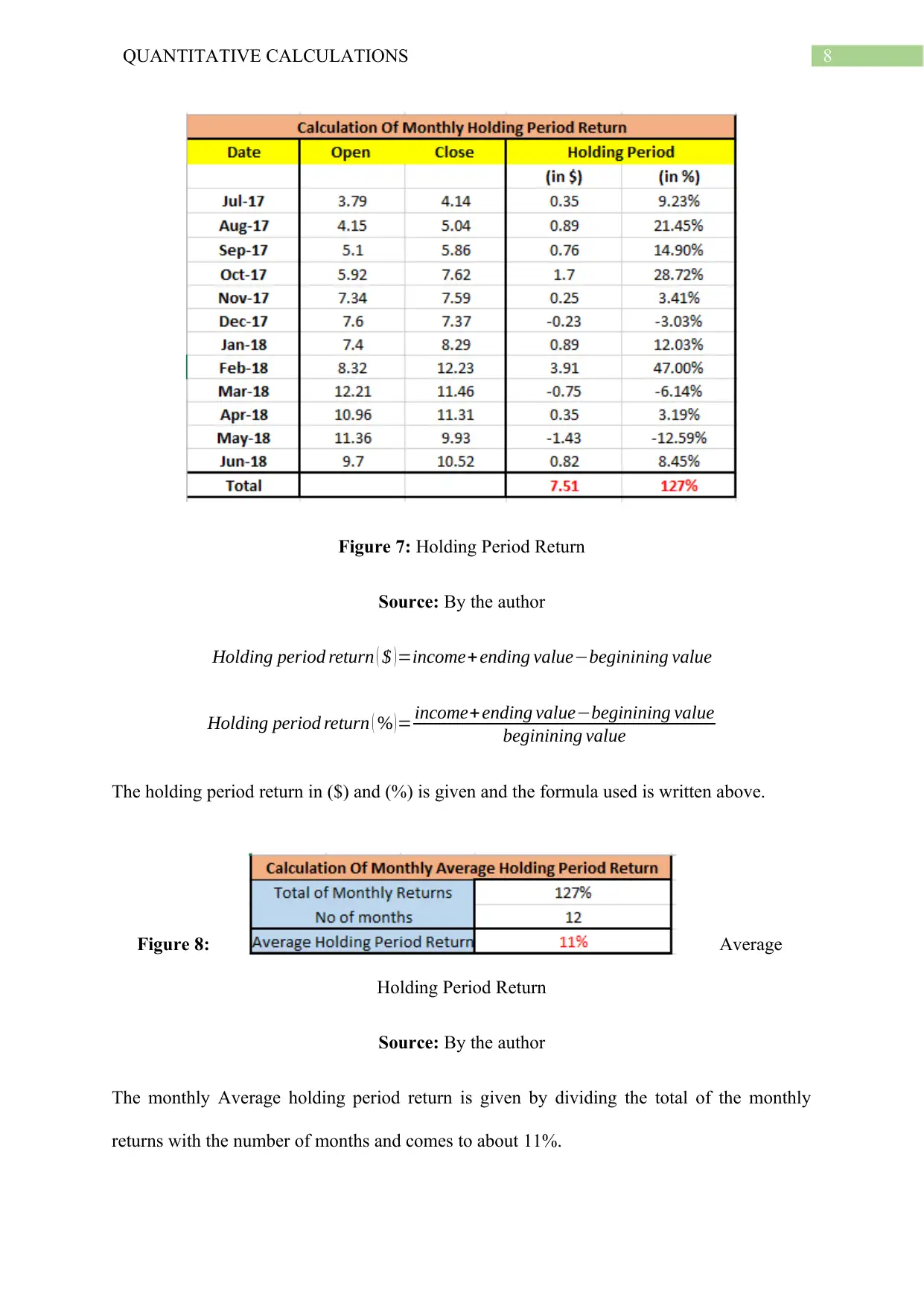
8QUANTITATIVE CALCULATIONS
Figure 7: Holding Period Return
Source: By the author
Holding period return ( $ )=income+ending value−beginining value
Holding period return ( % )= income+ending value−beginining value
beginining value
The holding period return in ($) and (%) is given and the formula used is written above.
Figure 8: Average
Holding Period Return
Source: By the author
The monthly Average holding period return is given by dividing the total of the monthly
returns with the number of months and comes to about 11%.
Figure 7: Holding Period Return
Source: By the author
Holding period return ( $ )=income+ending value−beginining value
Holding period return ( % )= income+ending value−beginining value
beginining value
The holding period return in ($) and (%) is given and the formula used is written above.
Figure 8: Average
Holding Period Return
Source: By the author
The monthly Average holding period return is given by dividing the total of the monthly
returns with the number of months and comes to about 11%.
⊘ This is a preview!⊘
Do you want full access?
Subscribe today to unlock all pages.

Trusted by 1+ million students worldwide
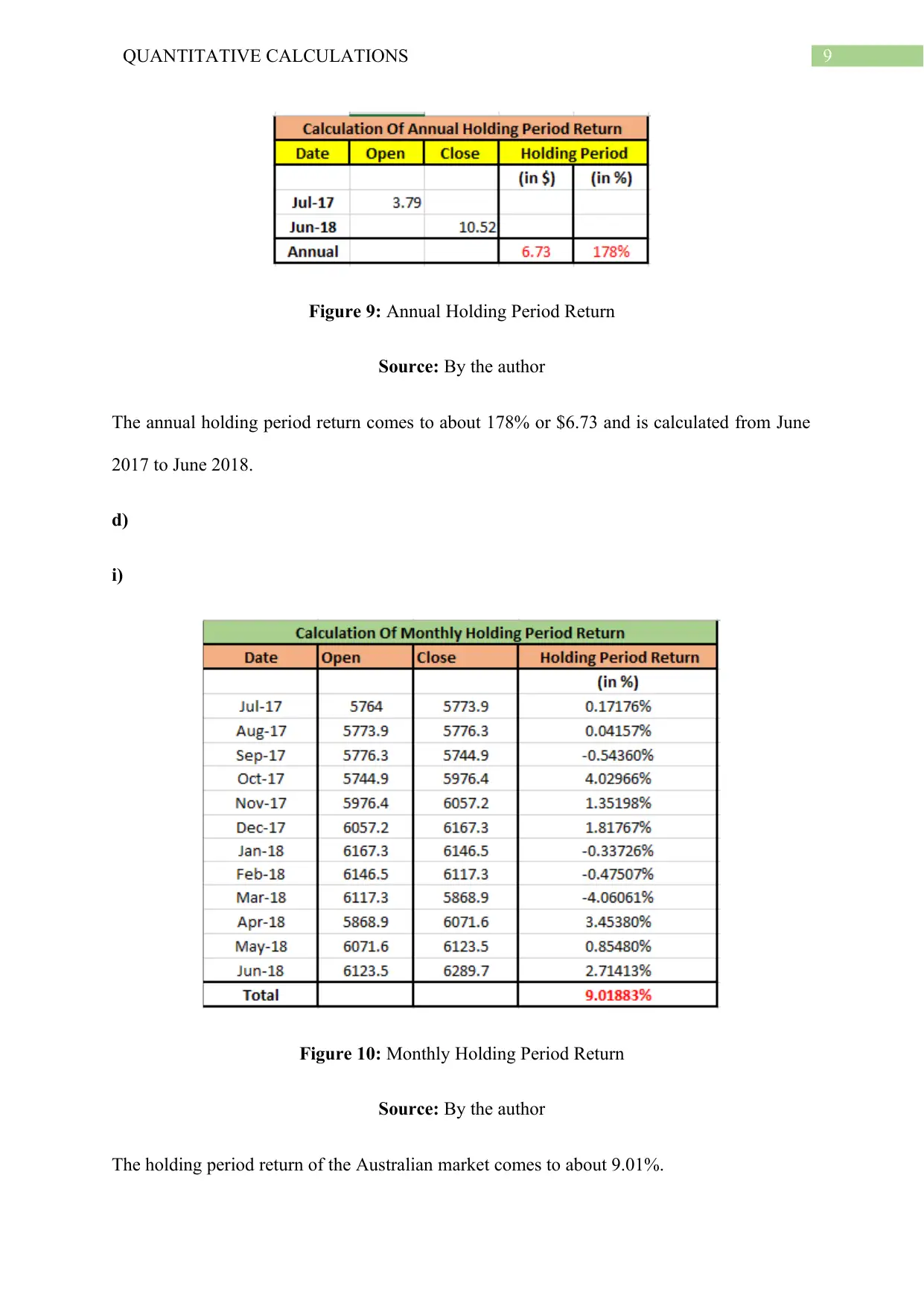
9QUANTITATIVE CALCULATIONS
Figure 9: Annual Holding Period Return
Source: By the author
The annual holding period return comes to about 178% or $6.73 and is calculated from June
2017 to June 2018.
d)
i)
Figure 10: Monthly Holding Period Return
Source: By the author
The holding period return of the Australian market comes to about 9.01%.
Figure 9: Annual Holding Period Return
Source: By the author
The annual holding period return comes to about 178% or $6.73 and is calculated from June
2017 to June 2018.
d)
i)
Figure 10: Monthly Holding Period Return
Source: By the author
The holding period return of the Australian market comes to about 9.01%.
Paraphrase This Document
Need a fresh take? Get an instant paraphrase of this document with our AI Paraphraser
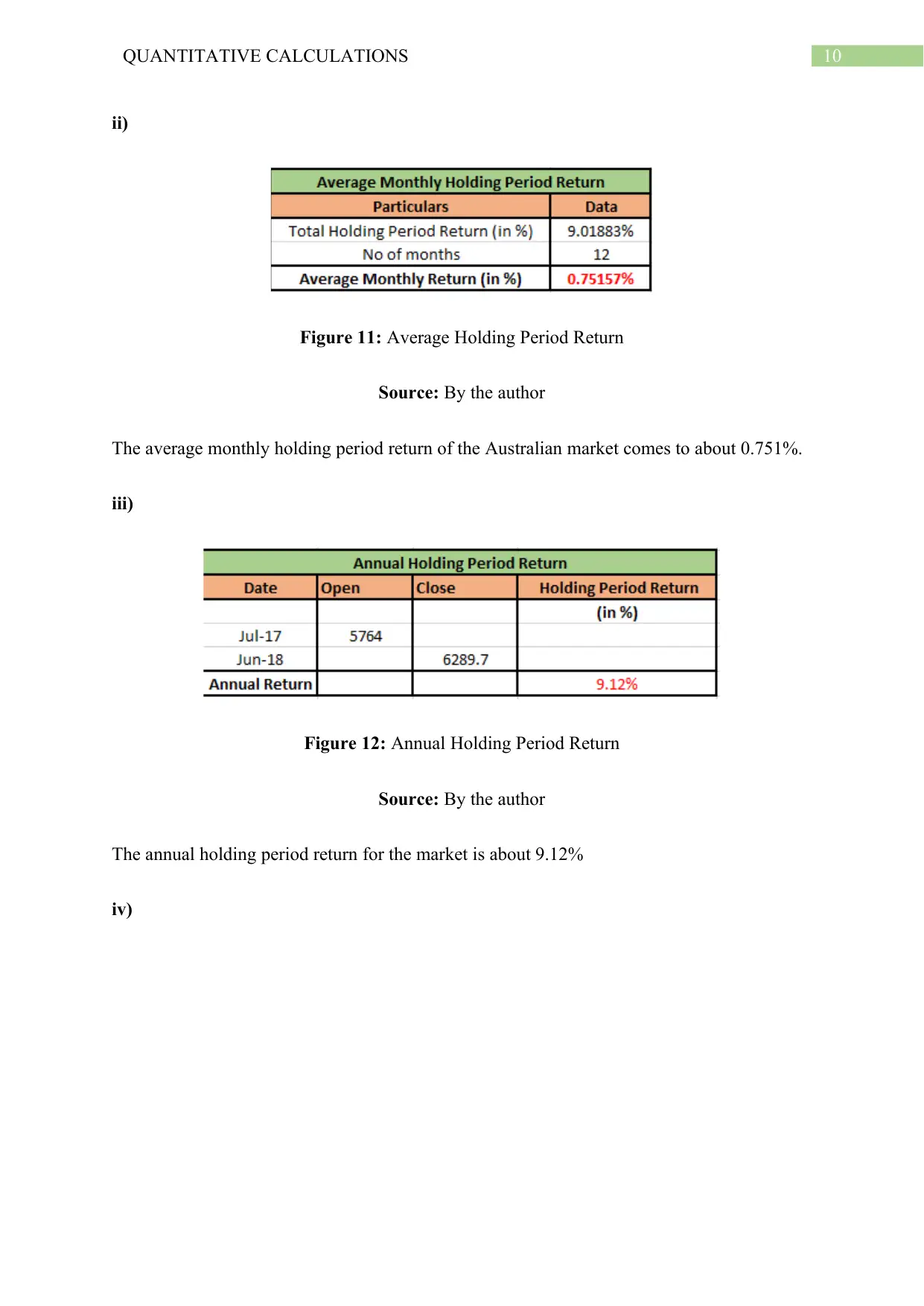
10QUANTITATIVE CALCULATIONS
ii)
Figure 11: Average Holding Period Return
Source: By the author
The average monthly holding period return of the Australian market comes to about 0.751%.
iii)
Figure 12: Annual Holding Period Return
Source: By the author
The annual holding period return for the market is about 9.12%
iv)
ii)
Figure 11: Average Holding Period Return
Source: By the author
The average monthly holding period return of the Australian market comes to about 0.751%.
iii)
Figure 12: Annual Holding Period Return
Source: By the author
The annual holding period return for the market is about 9.12%
iv)
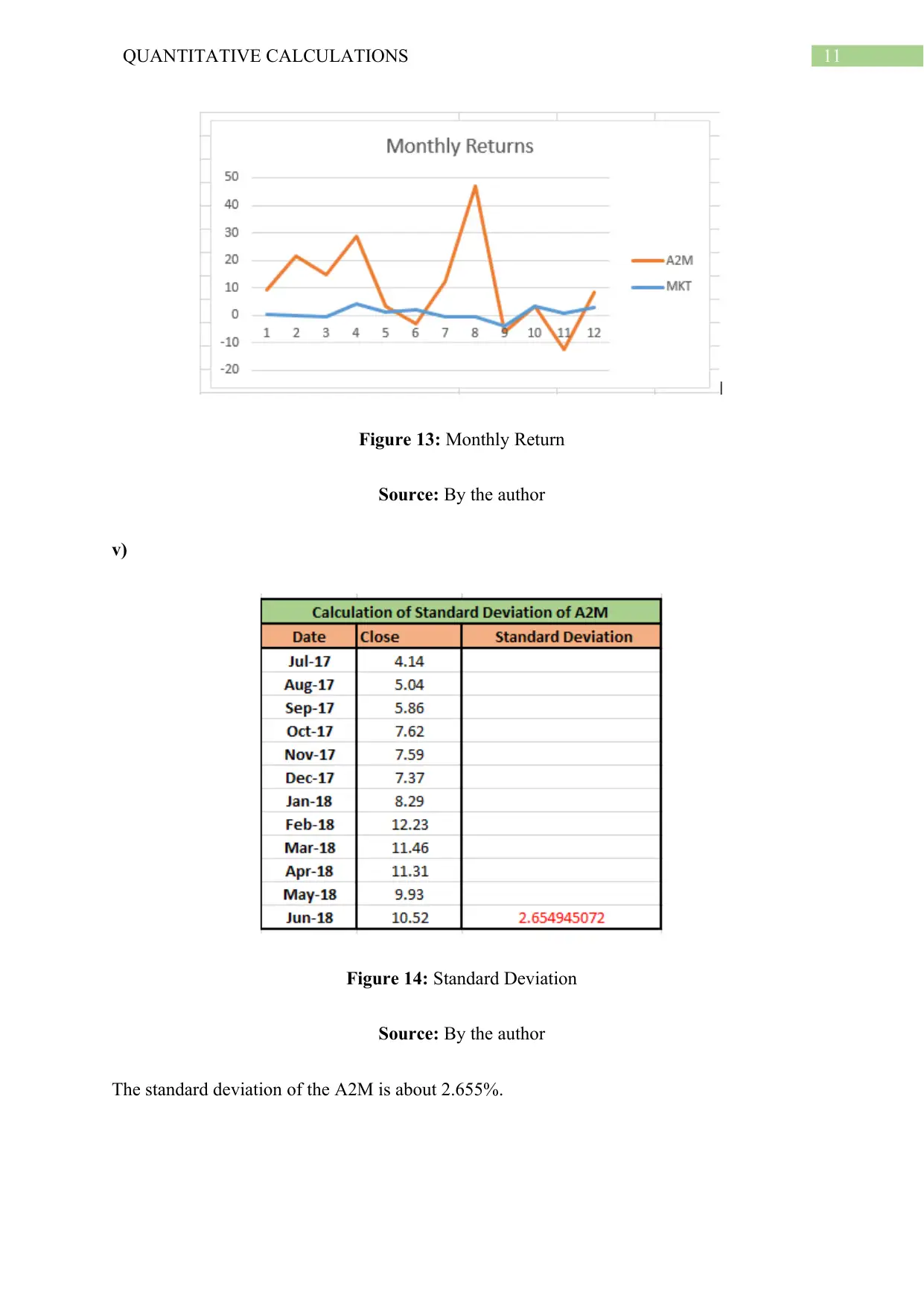
11QUANTITATIVE CALCULATIONS
Figure 13: Monthly Return
Source: By the author
v)
Figure 14: Standard Deviation
Source: By the author
The standard deviation of the A2M is about 2.655%.
Figure 13: Monthly Return
Source: By the author
v)
Figure 14: Standard Deviation
Source: By the author
The standard deviation of the A2M is about 2.655%.
⊘ This is a preview!⊘
Do you want full access?
Subscribe today to unlock all pages.

Trusted by 1+ million students worldwide
1 out of 16
Related Documents
Your All-in-One AI-Powered Toolkit for Academic Success.
+13062052269
info@desklib.com
Available 24*7 on WhatsApp / Email
![[object Object]](/_next/static/media/star-bottom.7253800d.svg)
Unlock your academic potential
Copyright © 2020–2025 A2Z Services. All Rights Reserved. Developed and managed by ZUCOL.




